As we age, the importance of finding an apartment that is comfortable and accommodating becomes increasingly evident. For those who wish to continue living independently in their later years, selecting an apartment with appropriate accessibility features is essential. In this guide, we’ll explore key accessibility features to consider when renting an apartment to support aging in place.
Start with the Right Apartment
To begin your search for an apartment that is suitable for aging in place, explore listings on platforms that make it easy to search for apartments for rent near me. Look for properties that offer features and amenities designed to enhance accessibility and convenience for seniors. Pay attention to details such as the building’s layout, location, and proximity to essential services like healthcare facilities, pharmacies, and public transportation.
Accessible Entryways
A critical consideration for aging in place is the ease of entry and exit from your apartment. Look for units with accessible entryways that do not require navigating stairs. Ground-floor apartments or those with ramps or elevators provide wheelchair-friendly access.
Wider Doorways and Hallways
Aging in place apartments should ideally have wider doorways and hallways to accommodate mobility aids such as wheelchairs or walkers. Standard doorways are typically 32 inches wide, but wider ones, around 36 inches, provide better accessibility.
No-Step Showers
Bathrooms with no-step or roll-in showers are a valuable feature for seniors. These showers eliminate the need to step over a high threshold, reducing the risk of slips and falls. Grab bars and non-slip flooring in the bathroom can also enhance safety.
Lever-Style Handles
Replace traditional doorknobs with lever-style handles on doors and faucets. Lever handles are easier to grasp and turn, making them more user-friendly for individuals with limited hand strength or dexterity.
Lower Light Switches and Thermostats
Lower light switches and thermostats to a height that is easily accessible from a seated position. This adjustment ensures that seniors can control lighting and temperature without stretching or reaching.
Ample Lighting
Proper lighting is crucial for aging in place. Choose apartments with ample natural light and well-placed electrical fixtures. Adequate lighting reduces the risk of falls and improves visibility throughout the apartment.
Anti-Slip Flooring
Opt for apartments with anti-slip flooring, particularly in high-risk areas like the kitchen and bathroom. Slip-resistant flooring materials, such as cork or non-slip tiles, provide additional stability and safety.
Easy-to-Reach Storage
Consider apartments with storage solutions that are easy to reach. Lower kitchen cabinets, adjustable shelving, and pull-out drawers can make accessing items more convenient for seniors.
Emergency Response Systems
Some apartment complexes offer emergency response systems that connect residents with emergency services at the push of a button. These systems can provide peace of mind and quick assistance in case of emergencies.
Community Amenities
When choosing an apartment for aging in place, also consider the accessibility of community amenities within the complex. Accessible fitness centers, community rooms, and outdoor spaces can contribute to a more active and fulfilling lifestyle.
Transportation Options
Evaluate the availability of transportation options in the vicinity of your apartment. Access to public transportation or proximity to essential services like grocery stores and medical facilities can be crucial for seniors who no longer drive.
Social Opportunities
Look for apartment communities that offer social activities and programs for seniors. Engaging in social activities can help combat isolation and promote a sense of community.
Flexibility in Lease Terms
Consider apartments that offer flexibility in lease terms, such as month-to-month rentals or shorter lease periods. This flexibility allows seniors to adapt their living situation to changing needs without long-term commitments.
Review the Lease Agreement
Before signing a lease, carefully review the terms and conditions related to accessibility modifications and accommodations. Ensure that the landlord is open to reasonable modifications to enhance accessibility if needed.
Seek Professional Advice
If you have specific accessibility requirements, consider seeking advice from professionals who specialize in aging in place solutions. Occupational therapists or accessibility consultants can provide valuable insights and recommendations.
Conclusion
Choosing the right apartment for aging in place is a significant decision that requires careful consideration of various accessibility features and amenities. By selecting an apartment that meets your specific needs and supports independent living, you can enjoy a comfortable and fulfilling lifestyle as you age. Remember to communicate openly with landlords or property managers about your requirements, and don’t hesitate to seek professional guidance if necessary. With the right planning, you can find an apartment that allows you to age in place with confidence and convenience.




